If you also like Web3 and hope to do something interesting and meaningful here, then I hope this article can help you.
For those who want to enter Web3 or have just entered Web3, but considering two reasons, I still intend to postpone this matter for some time.
First, when all the major media are advocating All In Web3, it is inevitable that many friends will be overwhelmed and quit their jobs in large factories, sprinting into the Web3 industry with the dream of getting rich. But that's not the right thing to do either for the industry or for you personally, and I don't want to add fuel to the fire at that point. I hope that everyone will think rationally before doing anything, and not be influenced by various voices. Now, with the gradual cooling of the market and the emergence of more and more doubts, people have begun to return to rationality, and a large number of speculators have left with abuse and empty wallets. If you still love this industry deeply at this time, Then I think you are the one who should devote himself to Web3, and I would also like to share some of my experiences and thoughts for your reference.

The second is that I really think that my understanding of the industry is not deep enough. I need more time to research projects, observe industry trends and community sentiment, and I don’t want to write a so-called tutorial early to mislead people. Of course, some friends may think that it is too late to enter Web3 now? I would like to say that it is never too late for you to enter Web3. The birth of blockchain is only a dozen years old, and the birth of artificial intelligence, which is also a cutting-edge technology, has been born for more than 60 years, so Web3 is really in a very early stage. stage. There are no authoritative leaders or experts here. Everyone is constantly learning and thinking. If you don’t pay attention to the market for a few days, you will be left behind by others. Everyone has equal opportunities, and the struggle is hard work and cognition.

If you also like Web3 and hope to do something interesting and meaningful here, then I hope this article can help you.
The following will describe a grand blueprint for Web3 in three parts: "Cognition", "Practice", and "Experience". After reading this article, you will get the answers to the following questions:
-
The core idea and correct understanding of Web3
-
Are you really suitable for Web3
-
From 0 to 1: Teach you to take the first step towards Web3
-
Ecological map: take you to examine the whole picture of Web3, public chain + DeFi + NFT + GameFi + DAO + SocialFi + infrastructure + technology stack + top investment institutions + common tools, to guide your Web3 road
-
From 1 to N: Teach you how to cultivate in a track step by step (build cognition, analyze projects, use tools)
-
The best posture to join Web3 (work, investment, entrepreneurship, private domain, personal IP)
-
A few industry principles that must be kept in mind
-
Web3 Dark Forest Anti-Cheat Handbook
1. Cognition
First of all, we need to think about a question: why do you want to enter the Web3 industry ? Is it from friends or marketing accounts that participating in Web3 can make you rich? Do you want to speculate and leave with a small profit? Did you hear this concept and want to learn it? Or do you really agree with the concept of encryption and love this industry?
The answer to this question does not need to be written down and announced to the public, you just need to keep it in your heart, so please keep nothing from yourself.
Ok, now that you have your answer, let's move on.
wealth?
I guess many of you are attracted by the wealth effect of Web3, which is not wrong, after all, who can not love money? But can Web3 really make you rich? Any field follows the 28-80 principle, and Web3 is even worse, and the people who really make money are often less than 10%. If you participate with the mentality of making yourself rich through Web3, you will probably end up losing everything. There are far more liars in Web3 than you can imagine, and some practices can even refresh your perception. You can’t trust anyone here except yourself! So we often say "DYOR" means Do Your Own Research. Protect your principal, and if you meet anyone who says you can make a stable profit, please block him directly.
But Web3 does also give many people the opportunity to cross classes. This is still a "primitive arena". There are no absolute rules and no unchanging leaders. Most of the power and relationships are isolated here, so that many people at the bottom have the opportunity to stand on the same starting line as the Wall Street elite.
A friend who resigned from Beijing and settled in Dali to do Web3 development said: The reason why you choose Web3 is because here everyone pays more attention to you as a person rather than your workplace identity; here, you are not a tool, and you don’t need to play a role As a business screw, you can have some vitality, no introversion, no layoffs, you can get a decent salary, you can enjoy the sun, you can not be overdrawn by meaningless work, and you can unleash your creativity to the fullest, which is much more comfortable.
So, how can such an industry not be fascinating?
Although the potential rewards are huge, it is also doomed to a difficult journey. Please don't trust those trading analysts on Twitter who accurately predict every ups and downs . If he has this ability, he will not tweet there. If a person really has the knack of making money, he will never show it off, let alone teach it to the friends here. Of course, Web3 also has some excellent KOLs who insist on preaching and dispelling doubts, but there are really few such people. You need to carefully distinguish and find seniors who match your style. So in Web3, you can refer to the opinions of some excellent KOLs, but please don’t simply imitate and copy, you need to slowly develop your own analysis framework and investment logic . The more you have experienced and the more you know, you are an expert, and you will have more opportunities to touch that bright dream.
idea?
To choose a field, you must at least agree with its philosophy.
Looking back at the birth stage of Bitcoin, from 2008 to 2009, it coincided with the global financial crisis, and people had distrust of centralized financial institutions. In fact, it was their wrong decisions that caused economic crises again and again. So at this time, a mysterious person (organization) with the pseudonym "Satoshi Nakamoto" proposed a peer-to-peer electronic cash system, which is Bitcoin. From then on, the currency can run away from the centralized banking system, and everyone's assets are in their own wallets, which are anti-censorship and traceable. Slowly people's beliefs have created today's Bitcoin, the cornerstone of encrypted culture.
Web3 is the sublimation of traditional encryption culture. It takes data ownership, decentralized identity, encrypted assets, and new business models as key elements. It focuses on building the next generation of value Internet and expands Crypto to a wider field. Big room for imagination. The creation of Bitcoin is a "miracle", and the ideal of Web3 is a "palace". However, while pursuing our dreams, we must also face some facts: the efficiency of decentralization is far inferior to that of centralization, and decentralization breeds There are many black industries and projects where scammers are rampant. It is also necessary to understand that many industries and many people do not need decentralized services.
Web3 geeks are willing to sacrifice efficiency in exchange for real data ownership; they are willing to take risks on their own without donating data to allow centralized institutions to provide "security services" for themselves, and refuse the recurrence of the "Prism Gate" incident; they are willing to accept all kinds of chaos in Web3 I am willing to believe in the future of Web3 and continue to fight for it.
If you are also willing to believe in Web3, then I recommend you to cultivate deeply in the industry. There are too many blue oceans here, and one day you can make a difference. But if you think Bitcoin is air, NFT is a scam, GameFi is meaningless Ponzi, and decentralization is a false proposition, then I think Web2 is more suitable for you, so many industries, so many opportunities, don’t force yourself to integrate into one disliked circles. So we have to understand the status quo: not everyone is suitable for Web3, especially at this stage!
awe
If you choose to enter Web3, you must first be in awe of this industry. Whether you were an executive of a large factory or a professor with a master's degree, you must accept yourself as a newcomer in Web3. The industry barriers of Web3 are very high. Regardless of technology, thinking alone requires a big change. You need to know the core idea of Web3, the ecological layout of the industry, and the best solutions among them. If you simply look at Web3 with Web2 thinking, you may not understand why many applications exist, why so many funds and players pour into such an "unsophisticated" product, and then conclude that Web3 is a scam.
Therefore, everyone should invest in the study and research of Web3 with an empty cup mentality, admit their ignorance of this industry, and build an understanding of the industry from scratch. This will be a relatively healthy growth path. No one in Web3 is absolutely right, and there is no unchanging authoritative leader. The industry is progressing and changing every day. Real learners should pay attention to market dynamics, community sentiment, and capital trends every day. Learning will also be abandoned by the market. This is different from many traditional industries. In some industries, the knowledge structure is basically fixed, and technology will not be greatly innovated in a short period of time. Therefore, many "experts" can "once and for all" and use the knowledge of the first 30 years to support the next 40 years. work, but this will not happen in Web3.
If you believe in the future of Web3, accept the chaos and disorder of Web3, enjoy this uncertainty, and have decided to flex your muscles here, then in the next chapter I will tell you how to set foot on the stage of Web3 with the right posture !
2. Practice
T-shaped talent
The in-depth participants of Web3 are "T-shaped talents". First of all, you need to establish an understanding of the entire industry, and then find an area of interest for in-depth research, become an expert in this field, and build a solid knowledge system horizontally and vertically. But the reality is not as expected. Many people only understand the superficial aspects of a certain field. For example, people who play NFT have no idea what DeFi is. Even some NFT practitioners I met don’t know what EVM is. There are connections between the various industries of Web3, just like Sudoswap created the NFT AMM mechanism. In fact, it is very similar to Uniswap V3, but how many people can tell what AMM is? Although ignorance of these will not prevent you from buying NFTs, but you may only stop at buying NFTs. If you want to cultivate in Web3 for a long time, then it is necessary to have a structural understanding of the entire industry.
For the steps to enter Web3, I recommend trying the learning path of "Public Chain-DeFi-NFT-GameFi-DAO, SocialFi-Infrastructure".
The public chain is the foundation of everything; DeFi is the engine of Web3; NFT is relatively independent and special, and it is a new application paradigm; GameFi needs the integration of "game + NFT + DeFi"; DAO and SocialFi focus more on people's perspectives Designed products; the knowledge involved in infrastructure tracks such as privacy and storage is relatively difficult to understand, and can be used as an extended class of learning. Of course, applications such as wallets and exchanges are necessities, so I won’t go into details here.
from 0 to 1
If you have decided to go down the road of Web3 at this time, let us knock on the door of Web3, continue reading, and find your interests:
1. Public chain
The public chain focuses on building the underlying foundation of Web3, and makes technical improvements and explorations around the "impossible triangle" of "decentralization, scalability, and security".
Take the recent new public chain projects Aptos and Sui as examples. Both of them adopt the Move language and the concept of transaction processing parallelization, and they are different in focus: Aptos moves faster, and the development of various ecological layouts is relatively complete. , the community is very popular, and many developers have gathered in a short period of time; while Sui's pace is obviously slower, but the core technology is stronger than Apots, whether it is lower and predictable Gas, validator incentives, and storage for separate payments With transaction fees or stronger security, these are very important for L1.
2. DeFi
DeFi is committed to improving the asset utilization efficiency of Web3 and building a decentralized financial system on the chain. It is the engine and connector of various projects, greatly enriching the application scenarios on the chain and providing users with new sources of benefits. Improved Token liquidity.
Lending and decentralized exchanges are the core of DeFi. On the lending platform, users deposit and lend tokens, and at the same time pay or earn interest (the same as the deposit and interest model in traditional finance); on decentralized exchanges, players deposit asset pairs into the liquidity pool (Liquidity Pool) provides liquidity and earns service fees. More importantly, DEX realizes the market price calibration of various tokens and the conversion between assets, which also allows various assets to flow more efficiently.
Liquidity mining (LiquidityMining) further strengthens the momentum of DeFi. It innovatively changed the company's profit distribution and governance model, and created a positive cycle of project development. Users obtain interest and project equity income through liquidity mining, and the project party also positively encourages the development of the project through fair issuance.
3. NFT
NFT expands the application field of Web3, making it develop from a single financial attribute to brands, physical objects, etc. This progress is of cross-age significance. If there is only FT on the chain, no matter how much Web3 develops, it is only a financial market, which is separated from the real world. If more people want to participate, Web3 needs to consider how to communicate with other fields, and NFT has Might be one of the correct answers.
Now the development of NFT is also in an absolute early stage. Although it has gone through a round of bull market, the projects that have emerged are basically PFP, and the only successful business model is Yuga Labs' "PFP-Land-Token-Game-Brand" The "ape" universe empire. But the most exciting thing is the community culture condensed by NFT, which brings together the most important factor - people. Even in the current slow growth, many communities are full of passion, so we have reason I believe that in the next narrative cycle, there will be dazzling NFT projects.
4. GameFi
Too few users is an important reason hindering the development of Web3, and GameFi is likely to open the door to this traffic. The Play2Earn model has attracted a large number of users to participate. Axie’s average daily income at its peak was higher than the per capita salary of some Southeast Asian countries. However, the current economic model of chain games is still imperfect, and almost no projects can escape the death spiral.
In fact, the essence of GameFi is still DeFi, and games are just its shell. The continuous development of the project requires sufficient liquidity, and the liquidity here largely requires the joining of new users. Players buy NFT to enter the game to increase the liquidity of the game, and some of the Token produced are self-consumed and sold to new users. This is the simplest inner loop. When the number of new users grows rapidly, the demand for NFT and Token increases, and the price rises. Players are friendly and the market is thriving, but when the growth of new users slows down, there are not enough ways to consume Tokens in the game ecosystem, the supply exceeds demand, and the price drops, and the price drop leads to a longer payback period, which will make new users The number dropped further, entering the rhythm of a death spiral.
Although facing difficulties, GameFi is definitely one of the most potential tracks. Recently, GameFi has also been favored by capital, and the amount of financing far exceeds that of other fields. In the next cycle, we have reason to believe that there will be more and more phenomenon-level chain games like StepN, and more people will enter Web3 through chain games.
5. DAO, SocialFi
SocialFi is the only track in this round of bull market that has no projects. Everyone basically agrees that social networking is a necessary demand and has a very high upper limit. CZ also publicly expressed his optimism for SocialFi at the beginning of the year. However, many institutions believe that the existing SocialFi projects are still in the early stages of development, and the model is not yet clear and a sustainable paradigm has not been formed. It is difficult to acquire users from traditional giants if we only rely on the token economy and the packaging transformation of Web2 social networking. However, some social projects have recently begun to be noticed by capital, and I hope to see good products from SocialFi in the next cycle.
DAO is a brand-new team organization structure with great vitality and efficiency. Since this concept was widely spread, various DAOs have sprung up and grown rapidly. I believe it will be a pioneering application, but it is not mature now. DAO is not just a WeChat group, nor is it a reason for capital to prostitute labor. With the improvement of organizational and governance tools and the improvement of people's awareness, DAO will definitely develop in a better direction.
Ecological map
Each track of Web3 has its own unique charm. You need to have a comprehensive understanding of the excellent projects and ecology of each track, and then find your favorite direction for in-depth research. In order to facilitate everyone's study, I have included the leading projects, common tools, top investment institutions, and development technology stacks in various fields of Web3 into the following figure, and made a brief summary of each project in one sentence. If you thoroughly study all the projects and tools in this picture, then you have definitely surpassed more than 90% of the people in Web3. While studying, you will discover your interests, find the track that belongs to you, and start to study in depth:
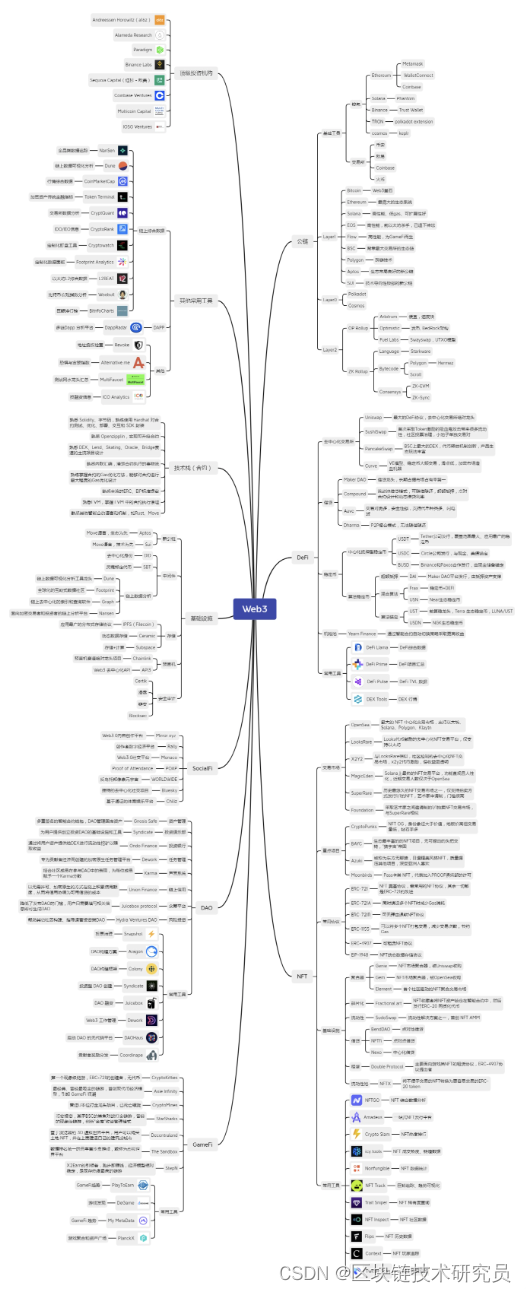
from 1 to N
At this point, you have selected the track, and the next problem you will face is how to cultivate on this track. I have prepared a detailed implementation plan for you. The whole process is divided into seven steps. Take a deep breath, let’s continue:
Step 1: Research the top 20 projects in this track, familiarize yourself with their development history and solutions
If you like NFT, then you should go to OpenSea and understand the top 20 projects in the ranking list from the early publicity, distribution method, post-operation, and ecological expansion to every step, think about their internal connections, and summarize why these projects can To become a blue chip; to understand those projects that were extremely popular at a certain moment, how they touched the emotions of the community, and why they did not continue the popularity; finally, I summed up my thinking logic on these projects and formed my own Research Framework.

If you like DeFi, then go to DeFi Llama, and understand the top 20 TVL projects in terms of white papers, problems to be solved, core solutions, economic models, development history, etc., and understand the evolution of the entire DeFi history , Understand the most significant features of each project, think about the connections between different projects, and build your own understanding of the entire DeFi ecosystem.
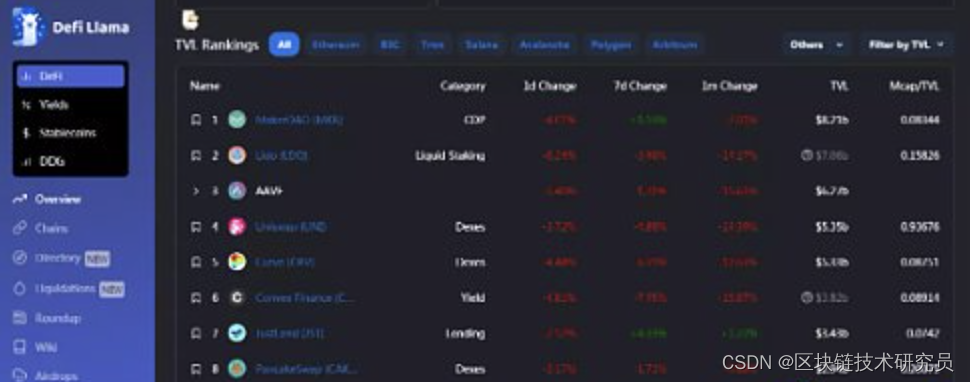
And so on in other fields. Remember: the premise of understanding the industry is that you have seen enough projects. Quantitative changes lead to qualitative changes. Don’t think that you are a genius. You can understand everything after reading a few interpretation articles and videos. You must respect the unknown industry. Modesty is The best learning attitude.
Step 2: Make good use of tools and use data analysis tools to conduct in-depth research on the project
If a worker wants to do a good job, he must first sharpen his tools. Although the data of most projects can be obtained on the chain, not everyone has a technical background. Players who do not understand technology can use some tools for auxiliary research. I put all the websites that may be used in the Web3 project research into the ecological map organized above. Here I take NFT as an example to briefly introduce some of the most commonly used websites.
Comprehensive data analysis website: NFTGO . The overall market data, segmented track data, individual project data, etc. are included. The website is very in line with the usage habits of Chinese people, and it is also a product of Chinese people. It is necessary to query data.
Role : analyze market and project data, and pay attention to whale trends.

Community data query website: NFT Inspect . It collects the Twitter community data of most NFT projects, including the number of topics, trends, avatar usage, etc., which fully reflects the community popularity of a project and is of great help to ambush a project in advance.
Function : Judging the popularity of the project based on community data, and taking corresponding actions.
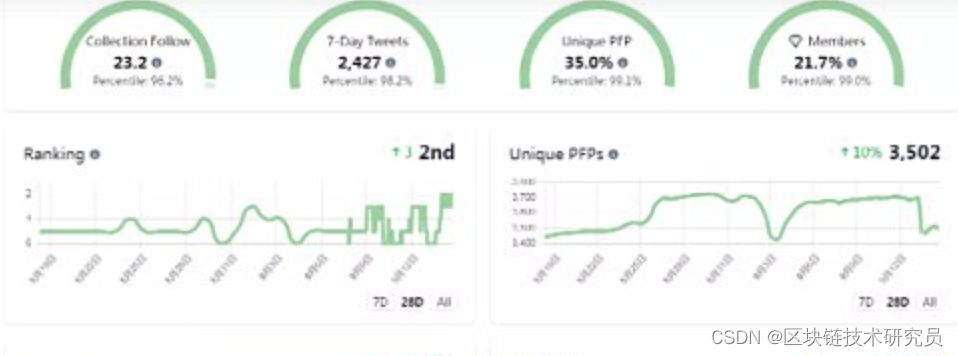
Project whale attention query website: TwitterScan . For the research of new projects, the higher the attention of project whales, the greater the development potential of the project in the later stage.
Function : It is generally used to judge whether the previous value of the project is worth the liver white, and to judge whether it will be pulled up based on the growth trend of whales.
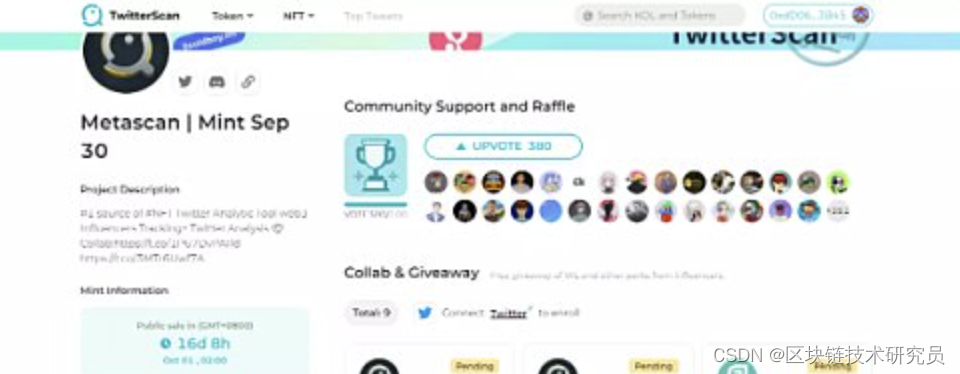
Project historical data query website: NFT Flips . View the data of the project itself, purchase trends in the secondary market, and monitor trends on the chain.
Function : In the early stage, it is judged whether the value of an item is worthy of Mint, and in the later stage, it is judged whether the value is worth level two.

In addition to the above websites, there will be many different needs in the process of your research project, and finding the right tool according to the needs is an essential skill.
Step 3: Broaden your own news channels and get the latest news about the project as soon as possible
After the above two steps, you already have an overall understanding of the industry and the ability to query project data. Next, you need to get an opportunity to discover excellent projects.
You have to understand a truth. When you see the "latest" news of a project in an article or video, it is basically not the latest. The opportunity is fleeting, and so many people are looking for it, so you must Get ahead. The best way to get the latest news about the project is various communities. Discord and WeChat groups are the most direct channels, but the premise must be that these communities are professional and sensitive enough. You need to find several high-quality communities. It will really help you a lot along the way. See a project in the community that most people are chasing, and research it right away! In addition, the dynamics of bloggers and project parties who focus on information release on Twitter are also very important. If you find it too troublesome to browse and search, you can also use TweetDeck to integrate the information flow.
Step 4: Learn to analyze new projects
At this point, you have already learned about a project that may have great potential from your community partners. Now you need to consider how to analyze a brand new project. Because it does not have data on the chain, the analysis process is the same as that described above. There are some differences, the reference steps are as follows:
-
Check the NFT picture to judge the quality and whether it conforms to the player's aesthetics and trends, especially pay attention to distinguish whether the item is a pirated picture
-
Check the Twitter of the project party, the main reference factors are: the number of followers, the degree of interaction activity, whether there are big names you follow who have followed this project, and initially observe the quality of the Twitter interaction of the project party to distinguish whether it is an active robot.
-
Use TwitterScan to view the number of project whale followers, and cooperate with the first step to analyze whether the project party has used robots to swipe activity
-
Join the Discord of the project party, observe the activity level and chat topics of the members, the response speed and accuracy of the mod of the project party, the operation of the Discord, etc.
-
Check the official website of the project party. From the overall design and details of the official website, you can see whether the project party is doing things seriously. Those websites that are directly modified with templates can basically be passed. In addition, the design concept, team, and FAQs of the project can also be found on the website. Find, these can help you distinguish between good and bad projects. Judging the development potential of the project, RUG probability, etc. based on the team behind the project.
-
Observe the operation methods of the project party, and the joint publicity with other projects and KOL
-
Track the operation of "Smart Wallet" in Mint, use NFT Flips to view Mint and the secondary market, and wait for the opportunity
-
After Mint, observe the trading frequency and pull strength, and choose short-term operation
-
Follow-up to choose the appropriate operation route according to the community sentiment
Step 5: Try to evaluate the pros and cons of the project solution and give suggestions for improvement
After you have seen enough projects, you will have your own unique understanding of this industry, and then you can make judgments on certain projects. Of course, I hope that all of this has a basis, not just "I think".
To summarize the reasons for the success or failure of a certain project, the differences between the solutions of several projects, why they are designed in this way, what problems are they designed to solve, and how their defects can be improved... When you are used to exploring things You will find that this industry is actually very pure and simple.
Step 6: Create your own personal IP
No matter which track you choose, I recommend you to record the learning content. If you like to write short articles, use Twitter, if you like to write long articles, use mirror, if you like to record videos, choose YouTube. In short, let more people watch To you, this will be of great help to you.
You may meet like-minded peers because of these contents, or you may be found by the project party and invite you to join their team, or it will become a very important basis for you when applying for a job. Web3 is a land of chaos, and there are too few truly valuable things here. Believe me, as long as you work hard enough, you will be discovered and gain the wealth and honor you deserve.
Step 7: Join Organization / Create Organization
It is too lonely to move forward alone, you need a partner, you need an organization, maybe it can give you emotional support, maybe it can give you material support, maybe it can bring you more thinking. In any case, a good team is of great benefit to your personal growth.
One thing to note here is that all your labor should be respected. Now many DAOs ask you to pay for nothing under the banner of "power generation for love", but this is actually prostitution for you. You have to understand what you want, money? connections? study? ... You can try a lot, but don't keep doing stupid things.
Some friends are not just satisfied with participating in other projects, but will end up making a product by themselves. This is very worth encouraging, and Web3 needs excellent Builders. The problem you face at this time will be to organize a team. As a sponsor, you need to spend a long time recruiting suitable partners, know everyone's characteristics well, and fully mobilize the enthusiasm of the team to accomplish this.
If you really like Web3 and really want to do something here, you can also contact me, and I will give you as much help as I can, not to mention guidance, but we can grow together.
3. Experience
This chapter will be presented in the form of questions and answers, trying to answer those difficult questions that bother you.
1. In what form can I join Web3?
Friends who have worked in Web2 for a period of time or who are about to graduate from university often ask this question, for example, I am doing product and development in a certain large factory, and now I want to enter Web3, what can I do, and what should I do now Woolen cloth?
First of all, the corporate organizational structure of Web3 is not much different from that of Web2. Positions such as product, development, and operation are the same. If your goal is to find a job in a Web3 company, you can refer to the above "ecological Graph" to learn and master the core knowledge structure of this industry. Technical positions require an in-depth study of the "technology stack" modules on the map, products require in-depth research on the project's architecture and economic model, and operations focus on the design of various activities in the community and project parties. It is relatively easy to find a job with a good salary after doing these researches thoroughly.
But in my opinion, working on Web3 is only the first layer, and the next second layer is participating in excellent projects (participating here does not mean working for it). There are very few in-depth participants of Web3 who only work and do not participate in other projects. In the words of a friend of mine, salary is just your subsistence allowance. The real value of Web3 lies in those excellent projects in the community. You won't be rich and free because of a salary that exceeds the industry average, but you may become famous because you are deeply involved in a reliable project. This narrative is no exaggeration, because such things often happen in Web3.
Generally speaking, the project party will give about 80% of the equity to the project supporters. If you find an excellent project through a series of research and continue to participate, believe me, your rewards will be considerable. However, it all depends on you being able to find great projects! 90% of projects in Web3 will die, and finding that pearl mixed in the fish's eye is a skill you have to hone.
The third layer is to establish personal IP and contribute to the development of the industry. Compared with tangible wealth, the shaping of personal value is more precious. Personal IP is gradually established in the process of personal development. The articles, videos, projects, and conferences you output will become the underlying foundation of IP. When you have enough experience and contacts, the next step is to give back to the industry. up.
You can think about the future trend and development direction from the perspective of industry layout, do your best to contribute to the development of Web3, launch an excellent product, and pursue higher life value. The information on the chain cannot be tampered with, all your contributions will be recorded, and your contribution to the industry will never be erased.
2. When you are new to Web3, what things should you know as soon as possible?
-
It's a chaotic industry with far more liars than good people
-
Don't trust anyone but yourself, the advice I can give you is don't trust anyone's investment advice
-
If you don't go deep into the market, you will never know what the market is like, and the judgments you make without practice are all mouthwatering
-
Pay attention to community sentiment, there is nothing that a fomo can't solve
-
Stop watching people bragging on Twitter and pay more attention to some high-quality bloggers
-
"God-level traders" who accurately predict every big rise and fall generally live on rebates
-
No more than 50 high-quality Chinese Web3 bloggers
-
The most direct way for the project to make profit is Token, and you too
-
Don't look down on masturbation, masturbation as you should, don't do it for nothing, sometimes the profit is very high
-
Have the courage to express your opinion after in-depth research, don't be afraid of ridicule, everyone is new, there are no experts here
-
Pay attention to wallet security, do not authorize at will, do not take screenshots of mnemonics, especially your own main wallet
-
Necessary knowledge of contracts can be of great advantage at certain times
-
Knowing how to sell is more important than knowing how to buy
-
Don't try to convince others of your point of view, be poor and live alone, don't do meaningless things
-
Although I don’t want to admit it, Chinese projects currently have the greatest risk of running away, and the market is generally not optimistic about Chinese projects
3. How can I prevent being cheated to the greatest extent?
Here you can directly refer to Manwu's "Dark Forest Self-Help Manual", and thank you @BTCOld8 for the picture summary:

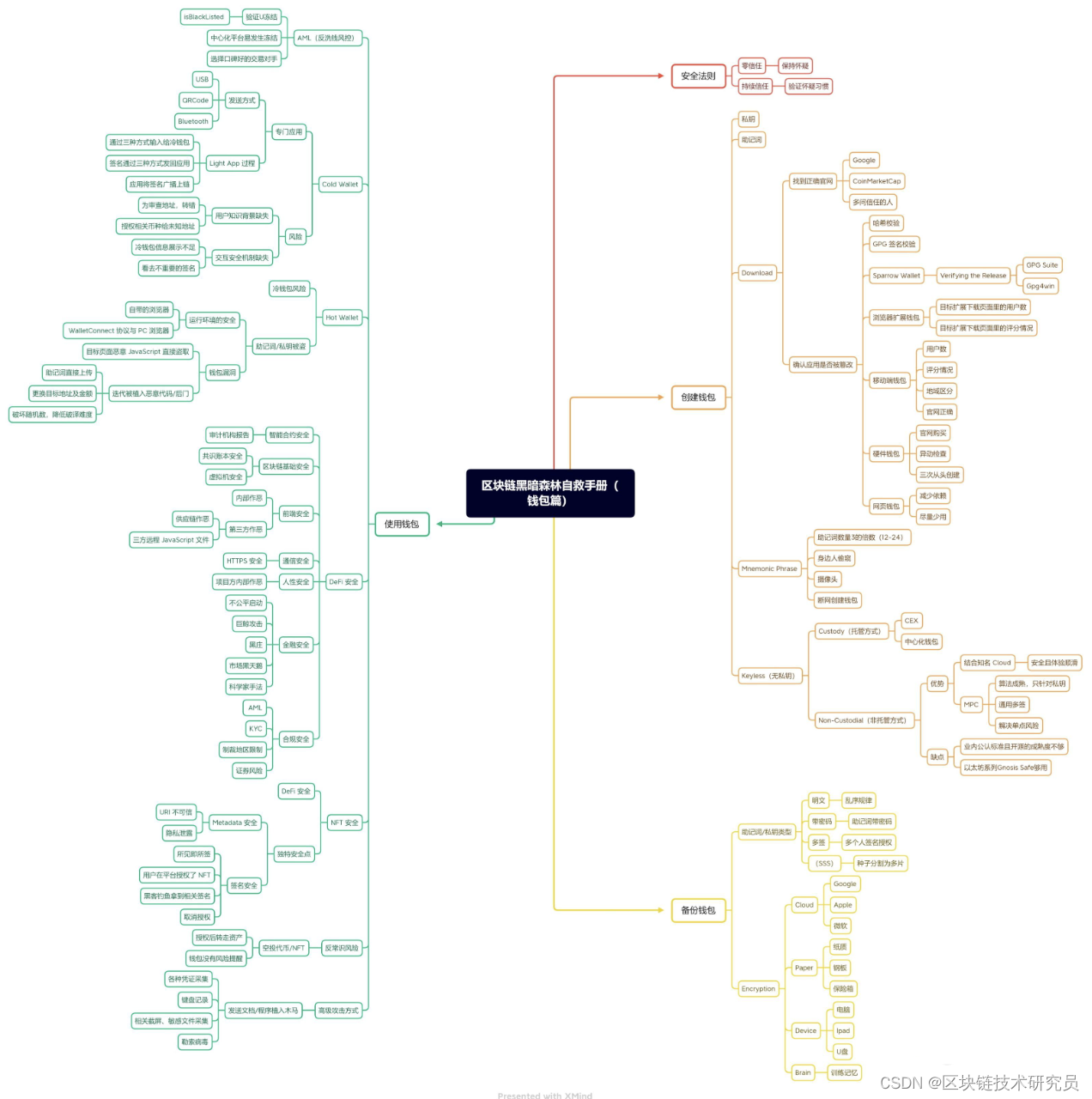
write at the end
Hope this tutorial inspires you, Web3 is in desperate need of more builders!
In addition, it is impossible to explain Web3 clearly in only about 10,000 words, and the content of the article will inevitably be overkill, so please treat it dialectically. If you want to have an in-depth communication with me on some aspects, please private message me and explain your purpose. The road of Web3 is not smooth, thank you for your construction and company!
Finally, I will end with the message written by F2Pool on the last block of the Ethereum PoW era: as long as you have the courage to make a promise, the world will help you remove insurmountable obstacles; to fulfill your unfulfilled dreams, the universe will never To restrain your progress, this is the essence.